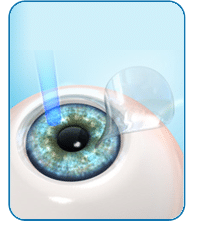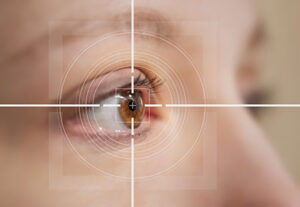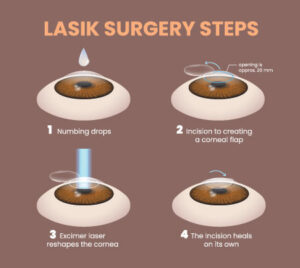Laser Vision Correction, also know as LASIK (Laser-Assisted in-Situ Keratomileusis), is laser eye surgery intended treat nearsightedness, farsightedness, and/or astigmatism and reduce the dependency on contact lenses and eye glasses. At Vista Eye, we use the latest technology for our pre-operative exams and vision correction procedures, including PRK and LASIK. All surgeries are performed by a fellowship trained laser vision correction and cornea specialist, Dr. Jani.
- OVERVIEW
- PROCEDURE
- RECOVERY
- LASIK VERSUS PRK
- REFRACTIVE ERRORS
- IDEAL CANDIDATES
- CHOOSING A LASER VISION CORRECTION SURGEON
- POSSIBLE RISKS
- LASIK COSTS
- TESTIMONIALS
- LASIK QUIZ
LASIK Overview
 The most common type of refractive surgery, LASIK, is an all laser procedure that can restore your vision. During LASIK, the eye surgeon creates a corneal flap with a femtosecond laser (All Laser LASIK) which is then folded over, so that the eye surgeon can precisely remove tissue from the cornea. By resculpting the corneal tissue, light focuses better into the eye, resulting in clearer vision. Excimer lasers can also be used to correct astigmatism by smoothing the surface of cornea to a more normal shape.
The most common type of refractive surgery, LASIK, is an all laser procedure that can restore your vision. During LASIK, the eye surgeon creates a corneal flap with a femtosecond laser (All Laser LASIK) which is then folded over, so that the eye surgeon can precisely remove tissue from the cornea. By resculpting the corneal tissue, light focuses better into the eye, resulting in clearer vision. Excimer lasers can also be used to correct astigmatism by smoothing the surface of cornea to a more normal shape.
The popularity of LASIK is due to many advantages, which include:
- Freedom from or less dependence on glasses and contacts
- Recovery time of 1-2 days
- Actual surgery lasting 10-20 minutes
- Little or no discomfort
- Immediate results by the next day
- Both eyes can be treated the same day
LASIK Procedure
The eye surgeon will first create a corneal flap using a femtosecond laser. After folding the flap back, Dr. Jani will use an excimer laser to reshape the cornea’s curvature to the precise correction (steepened for far-sighted patients, flattened for near-sighted patients).
The laser treatment typically lasts 30 seconds or less depending upon the amount of correction desired. After the cornea is resculpted, the corneal flap is put back in place, like a natural bandage. The entire procedure takes about 10 minutes per eye, and patients are often ready to leave within an hour. The eye heals on its own within a few days with no need for stitches.
The outer layer of the cornea, or epithelium, is a soft, rapidly regrowing layer that regenerates within a few days with no loss of clarity. In LASIK, the epithelium is not removed as in PRK; a flap is used to uncover the deep layers of the cornea. Thus, the recovery time is faster for LASIK. The deeper layers of the cornea, as opposed to the outer epithelium, have very limited regenerative capacity.
At Vista Eye Specialists, we utilize the latest technology, including Intralase and WaveLight® Technology.
LASIK Recovery
With LASIK surgery, most people’s vision improves right away, but some find that their vision gradually improves even more over the next few days or even weeks. The recovery time for LASIK is typically 1-2 days. Eye shields are worn after the procedure and it is imperative that the eyes are not rubbed or disturbed for the first 48 hours or the corneal flap created during the procedure could be disturbed and lead to wrinkling of the flap. The various eye drops prescribed by your eye surgeon will help the healing process, while over-the-counter pain relievers may also be helpful to relieve any discomfort.
Vista Eye recommends patients have a few days of rest for recovery. While some activities, like driving and going back to work can resume after a couple of days, certain activities, such as swimming and strenuous exercise, will be limited during the weeks following surgery to avoid any trauma to the eyes.
LASIK versus PRK
LASIK involves creating a corneal flap and shaping the cornea, while no flap is created during PRK. Both PRK and LASIK can be done on both eyes at the same time, however, the recovery time is typically longer with PRK.
For many patients, LASIK is their first choice for laser vision correction due to less recovery time and discomfort levels. However, PRK is a safe, successful alternative for patients who are not good candidates for LASIK or choose not to have a corneal flap for their laser vision correction procedure. Studies have demonstrated in the long term, PRK and LASIK are very equivalent procedures in so far as vision is concerned however the primary difference is the speed of visual recovery.
Difference between LASIK and PRK
Refractive Errors That LASIK Can Help You to Overcome
 A refractive error is a problem that causes light to bend incorrectly to the retina, resulting in blurry vision. LASIK or PRK is effective at treating the three most common types of refractive errors:
A refractive error is a problem that causes light to bend incorrectly to the retina, resulting in blurry vision. LASIK or PRK is effective at treating the three most common types of refractive errors:
- Myopia: Better known as nearsightedness, this condition makes it difficult for you to see objects in the distance, while your near vision remains clear. Myopia occurs when the cornea’s curvature is sharper than normal.
- Hyperopia: Better known as farsightedness, hyperopia is the contrast to myopia in that your up-close vision is blurry, while your distance vision is less blurry. Here, the cornea’s curvature is flatter than normal.
- Astigmatism: This condition is the result of multiple corneal irregularities that can make vision blurry at various distances.
Candidates for LASIK
By undergoing a comprehensive eye exam, Dr. Jani will be able to determine if you are an ideal candidate for LASIK. There are many factors that the doctor considers when developing a vision correction plan for you. At Vista Eye, we always consider the overall health of your eye, your current glasses prescription and your vision goals. After your thorough eye exam, Dr. Jani may decide that LASIK is not the best vision correction choice and may need to discuss other options in order for you to get the best vision results possible.
Some of the attributes to good candidacy for LASIK include:
- Adequate corneal thickness and corneal curvature
- Stable eye prescription for at least 12 months
- Good physical and ocular health
- Realistic expectations regarding results and vision potential after laser vision correction
- A good understanding of the risks and benefits of LASIK
Selecting Your Surgeon
At Vista Eye Specialists, we realize you have many options for laser vision correction. We feel that the right eye surgeon can often be the difference between a successful procedure and one with a suboptimal result. Asking the right questions is very important when selecting a quality surgeon. We have included this list of questions below to better educate laser vision correction candidates as to what they should look for when selecting a surgeon.
- Is your eye surgeon board certified and fellowship trained in Laser Vision Correction and Cornea?
- Does your surgeon perform other types of refractive surgery or LASIK only?
- Will your surgeon perform part or all of your refractive surgery (LASIK) evaluation?
- How long has your surgeon been performing laser vision correction eye surgery?
- What is your surgeon’s success rate with LASIK/PRK eye surgery?
- Does the eye surgeon see patients post-operatively?
- Do you feel comfortable with your eye surgeon and the level of personal attention you receive?
LASIK Eye Surgery Risks
As with any surgery, there are risks involved. Some risks that can be temporary or permanent include:
- Dry eyes
- Persistent glare and / or halos
- Under or over-correction of your prescription
- Recurrence of myopia or hyperopia
- Corneal haze
- Scarring
- Pain
- Reduced best corrected visual acuity
- Reduced acuity in low light
With LASIK, as with all types of refractive surgery, dry eyes is the most common risk of surgery and can be permanent.
Some LASIK patients have complained of glare and halos, but many times these symptoms are resolved after a few months as part of the healing process. Under or over correction of the refractive error is possible, especially with more severe myopia, hyperopia, and astigmatism, since the predictability of healing becomes less exact.
LASIK Costs
Vista Eye Specialists offer LASIK or PRK at a competitive price for the quality of service and advanced technology that we provide. We frequently offer specials and provide interest free financing options to make payments more manageable for our patients. FSA and HSA funds may be utilized for laser vision correction as well.. To find out our current rates, schedule a consultation or contact our office.
LASIK Testimonials
“I had LASIK about a month ago, and I am thrilled with my results. Everyone at Vista Eye Specialists is professional and friendly. Dr. Jani is an excellent doctor. I have had no issues with my eyes and now have better than 20/20 vision.” – Andrea T.
“I noticed during my initial exams that Dr. Jani’s staff had an appreciation and respect for his experience in the field. This gave me confidence in his abilities. Throughout the surgery, I received constant verbal feedback like ‘you’re doing great’ that I found reassuring. My recovery went well, billing was pretty simple, and now my vision is 20/20. It’s an incredible feeling to wake up in the morning and already have perfect vision.” – Paul H.
“Dr. Jani and his entire staff were unbelievably friendly. They always were available to answer my questions and dealt with my anxiety on the day of my surgery calmly and with positivity. The office is modern and the whole process was efficient. Less than 18 hours after LASIK, my vision was already 20/20 with no irritation. I highly recommend this office if you are considering LASIK.” – Megan R.
LASIK Quiz
If you are considering LASIK, schedule a FREE consultation with Dr. Jani, a fellowship trained laser vision correction and cornea specialist, to find our about what technology will meet your vision needs for the best possible outcome. After all your eyes are too important to trust to just anyone! Please contact Vista Eye for more information about LASIK technologies, or to schedule an appointment by calling toll free at (888) 393-5264.
LASIK FAQs
Is Financing Available?
Yes. Vista Eye Specialists offers a variety of payment options. Please call us toll free at 888-393-5264 for more details and to find out about our interest free financing options.
When Can I Go Back To Work?
 Generally, most LASIK patients can go back to work the next day. If you have PRK, you may need to take a few additional days off.
Generally, most LASIK patients can go back to work the next day. If you have PRK, you may need to take a few additional days off.
Will I Still Need Reading Glasses?
If you are in your mid 40s and are wearing reading glasses prior to LASIK surgery, then yes, you will still have to wear reading glasses after the procedure. Anyone under the age of 40, who has LASIK, will still need reading glasses in the future when they reach their early to mid 40s. If you are around the age of 50 and would like to reduce your dependence on reading glasses, there may be other options, like premium IOLs available to you.
What Are The Benefits Of LASIK?
Laser vision correction is highly successful in reducing nearsightedness, farsightedness and astigmatism. The majority of patients achieve excellent visual acuity which allows them to reduce the dependency for glasses to drive, play sports, enjoy outdoor activities, and watch TV. Most patients can return to work or normal activity the day after LASIK surgery.
Will laser vision correction address my need for reading glasses (presbyopia)?
Presbyopia occurs due to natural changes in the lens in people over the age of 40. Because LASIK is a corneal reshaping surgery that does not touch the lens, it does not improve vision affected by presbyopia. If you are interested in reducing your dependence on reading glasses, you may be a better candidate for another refractive surgery like refractive lens exchange, which replaces your natural lens with a premium artificial lens.
Will I be awake during the laser vision correction procedure?
Yes, you will remain awake so that you can keep your eyes looking at any targets your surgeon requests.. Fortunately, you should experience no significant discomfort during your proceedure thanks to numbing eye drops. You also do not need to worry about blinking since we use a eye lid speculum to keep your lids out of the way.


